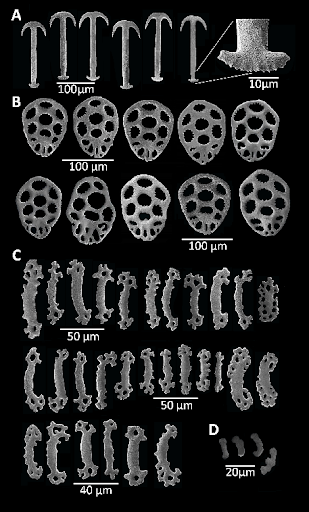The Marine Invertebrate Collection Curatorial Assistant, Sheila Byers, has had the great pleasure of working with Dr. Francisco Solis-Marin, an expert taxonomist specializing in Echinoderms—the spiny-skinned invertebrates of our oceans. Francisco is on sabbatical from the National Collection of Echinoderms, Universidad Nacional Autónoma de México (UNAM) in Mexico City. For the past six months, Francisco has worked through our wet (alcohol-based) and dry specimens of sand dollars, sea urchins, sea biscuits, sea cucumbers, sea stars, brittle stars, basket stars examining more than 1,000 specimens and identifying more than 90 species. These specimens were collected in the past from all over the world from England to Antarctic.
The sea cucumbers, however, are Francisco’s favourite group of echinoderms. Sea cucumbers, shaped like the cucumber vegetable are an odd shape compared to the other groups of echinoderms. The sea cucumbers generally crawl about the seafloor using their tube feet, somewhat like the sand dollars and urchins.
To his great surprise, Francisco found a new species of sea cucumber (Epitomapta aumakua) in the collection. The species name for the new cucumber aumakua, refers in Hawaiian mythology, to a person or family god that originated as a deified ancestor, who takes on physical forms as spirit vehicles.
ZooKeys 1183: 73–80 (2023)
DOI: 10.3897/zookeys.1183.111620
It is not a large cucumber, less than 2 cm in length. The specimen label identified the collection from Kualoa, O’ahu, Hawaii in a habitat as coarse sand and shallow depth of 2.5 m. By comparison, our local BC giant California cucumber (Apostichopus californicus) reaches 50 cm in length and found at depths from intertidal to 247 m! Regardless of size, there is one very important difference between these sea cucumbers—tube feet (podos)! The giant cucumber uses tube feet on its underside to crawl along the seafloor. The cucumbers lacking tube feet are apodous cucumbers. The new species is an apodous cucumber. Most of the apodous cucumbers burrow and feed within the sediments as opposed to crawling on top of the seafloor sediment.

Young giant California. Image source: Washington State by Dave Cowles, http://rosario.wwc.edu/inverts

Tube feet on undersurface of cucumber. Image source: Washington State by Dave Cowles, http://rosario.wwc.edu/inverts
On examination of the small MIC cucumber specimen, Francisco immediately recognized some of the external morphological characteristics. In 2019, he described a new species, Epitomapta simentalae, from the Central Eastern Pacific coast of Mexico. But could this species be from Hawaii such a distance away!?

“Epitomapta simentalae”, a larger cousin of E. aumakha.
Characteristics of E. aumakua, like the tentacles, body wall and papillae were different. Delving deeper with microscopic examination, he saw distinct differences in the shapes of the anchors in the body wall that the cucumbers use to move in the sediment. They were very distinctive when magnified using electron microscopy as shown in this Figure 1.

Figure 1. “Epitomapta aumakua” sp. nov. Holotype MI 4942 A anchors from mid-body, showing the detail of the posterior part B anchor plates from mid-body C rods from tentacles D miliary granules from the body wall.
*Colección Nacional de Equinodermos “Dra. Ma. Elena Caso Muñoz”, Laboratorio de Sistemática y Ecología de Equinodermos, Instituto de Ciencias del Mar y Limnología (ICML), Universidad Nacional Autónoma de México (UNAM), Mexico City, C.P. 04510, Mexico.
